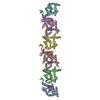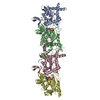[English] 日本語
 Yorodumi
Yorodumi- PDB-9bhw: Septin Tetrameric Complex SEPT7/SEPT9 of Ciona intestinalis by Cryo-EM -
+ Open data
Open data
- Basic information
Basic information
| Entry | Database: PDB / ID: 9bhw | ||||||||||||
|---|---|---|---|---|---|---|---|---|---|---|---|---|---|
| Title | Septin Tetrameric Complex SEPT7/SEPT9 of Ciona intestinalis by Cryo-EM | ||||||||||||
 Components Components |
| ||||||||||||
 Keywords Keywords | CELL CYCLE / Complex / SPA / Cytoskeleton | ||||||||||||
| Function / homology |  Function and homology information Function and homology informationcleavage apparatus septin structure / septin complex / cytoskeleton-dependent cytokinesis / septin ring / cell division site / cleavage furrow / cytoskeleton organization / kinetochore / spindle / intracellular protein localization ...cleavage apparatus septin structure / septin complex / cytoskeleton-dependent cytokinesis / septin ring / cell division site / cleavage furrow / cytoskeleton organization / kinetochore / spindle / intracellular protein localization / microtubule cytoskeleton / midbody / molecular adaptor activity / cilium / GTPase activity / GTP binding Similarity search - Function | ||||||||||||
| Biological species |  | ||||||||||||
| Method | ELECTRON MICROSCOPY / single particle reconstruction / cryo EM / Resolution: 2.72 Å | ||||||||||||
 Authors Authors | Mendonca, D.C. / Pereira, H.M. / Garratt, R.C. | ||||||||||||
| Funding support |  Brazil, 3items Brazil, 3items
| ||||||||||||
 Citation Citation |  Journal: J Mol Biol / Year: 2024 Journal: J Mol Biol / Year: 2024Title: Structural Insights into Ciona intestinalis Septins: Complexes Suggest a Mechanism for Nucleotide-dependent Interfacial Cross-talk. Authors: Deborah C Mendonça / Sinara T B Morais / Heloísa Ciol / Andressa P A Pinto / Diego A Leonardo / Humberto D'Muniz Pereira / Napoleão F Valadares / Rodrigo V Portugal / Bruno P Klaholz / ...Authors: Deborah C Mendonça / Sinara T B Morais / Heloísa Ciol / Andressa P A Pinto / Diego A Leonardo / Humberto D'Muniz Pereira / Napoleão F Valadares / Rodrigo V Portugal / Bruno P Klaholz / Richard C Garratt / Ana P U Araujo /   Abstract: Septins are filamentous nucleotide-binding proteins which can associate with membranes in a curvature-dependent manner leading to structural remodelling and barrier formation. Ciona intestinalis, a ...Septins are filamentous nucleotide-binding proteins which can associate with membranes in a curvature-dependent manner leading to structural remodelling and barrier formation. Ciona intestinalis, a model for exploring the development and evolution of the chordate lineage, has only four septin-coding genes within its genome. These represent orthologues of the four classical mammalian subgroups, making it a minimalist non-redundant model for studying the modular assembly of septins into linear oligomers and thereby filamentous polymers. Here, we show that C. intestinalis septins present a similar biochemistry to their human orthologues and also provide the cryo-EM structures of an octamer, a hexamer and a tetrameric sub-complex. The octamer, which has the canonical arrangement (2-6-7-9-9-7-6-2) clearly shows an exposed NC-interface at its termini enabling copolymerization with hexamers into mixed filaments. Indeed, only combinations of septins which had CiSEPT2 occupying the terminal position were able to assemble into filaments via NC-interface association. The CiSEPT7-CiSEPT9 tetramer is the smallest septin particle to be solved by Cryo-EM to date and its good resolution (2.7 Å) provides a well-defined view of the central NC-interface. On the other hand, the CiSEPT7-CiSEPT9 G-interface shows signs of fragility permitting toggling between hexamers and octamers, similar to that seen in human septins but not in yeast. The new structures provide insights concerning the molecular mechanism for cross-talk between adjacent interfaces. This indicates that C. intestinalis may represent a valuable tool for future studies, fulfilling the requirements of a complete but simpler system to understand the mechanisms behind the assembly and dynamics of septin filaments. | ||||||||||||
| History |
|
- Structure visualization
Structure visualization
| Structure viewer | Molecule:  Molmil Molmil Jmol/JSmol Jmol/JSmol |
|---|
- Downloads & links
Downloads & links
- Download
Download
| PDBx/mmCIF format |  9bhw.cif.gz 9bhw.cif.gz | 208 KB | Display |  PDBx/mmCIF format PDBx/mmCIF format |
|---|---|---|---|---|
| PDB format |  pdb9bhw.ent.gz pdb9bhw.ent.gz | 162.4 KB | Display |  PDB format PDB format |
| PDBx/mmJSON format |  9bhw.json.gz 9bhw.json.gz | Tree view |  PDBx/mmJSON format PDBx/mmJSON format | |
| Others |  Other downloads Other downloads |
-Validation report
| Summary document |  9bhw_validation.pdf.gz 9bhw_validation.pdf.gz | 1.6 MB | Display |  wwPDB validaton report wwPDB validaton report |
|---|---|---|---|---|
| Full document |  9bhw_full_validation.pdf.gz 9bhw_full_validation.pdf.gz | 1.6 MB | Display | |
| Data in XML |  9bhw_validation.xml.gz 9bhw_validation.xml.gz | 53.5 KB | Display | |
| Data in CIF |  9bhw_validation.cif.gz 9bhw_validation.cif.gz | 75.7 KB | Display | |
| Arichive directory |  https://data.pdbj.org/pub/pdb/validation_reports/bh/9bhw https://data.pdbj.org/pub/pdb/validation_reports/bh/9bhw ftp://data.pdbj.org/pub/pdb/validation_reports/bh/9bhw ftp://data.pdbj.org/pub/pdb/validation_reports/bh/9bhw | HTTPS FTP |
-Related structure data
| Related structure data |  44555MC  9bhtC M: map data used to model this data C: citing same article ( |
|---|---|
| Similar structure data | Similarity search - Function & homology  F&H Search F&H Search |
- Links
Links
- Assembly
Assembly
| Deposited unit | 
|
|---|---|
| 1 |
|
- Components
Components
| #1: Protein | Mass: 48769.039 Da / Num. of mol.: 2 Source method: isolated from a genetically manipulated source Source: (gene. exp.)   #2: Protein | Mass: 41559.363 Da / Num. of mol.: 2 Source method: isolated from a genetically manipulated source Source: (gene. exp.)   #3: Chemical | ChemComp-GDP / Has ligand of interest | Y | |
|---|
-Experimental details
-Experiment
| Experiment | Method: ELECTRON MICROSCOPY |
|---|---|
| EM experiment | Aggregation state: PARTICLE / 3D reconstruction method: single particle reconstruction |
- Sample preparation
Sample preparation
| Component | Name: Ciona intestinalis Septin Tetrameric Complex SEPT7/SEPT9 Type: COMPLEX / Entity ID: #1-#2 / Source: RECOMBINANT |
|---|---|
| Source (natural) | Organism:  |
| Source (recombinant) | Organism:  |
| Buffer solution | pH: 8 |
| Specimen | Embedding applied: NO / Shadowing applied: NO / Staining applied: NO / Vitrification applied: YES |
| Vitrification | Cryogen name: ETHANE |
- Electron microscopy imaging
Electron microscopy imaging
| Experimental equipment |  Model: Titan Krios / Image courtesy: FEI Company |
|---|---|
| Microscopy | Model: FEI TITAN KRIOS |
| Electron gun | Electron source:  FIELD EMISSION GUN / Accelerating voltage: 300 kV / Illumination mode: FLOOD BEAM FIELD EMISSION GUN / Accelerating voltage: 300 kV / Illumination mode: FLOOD BEAM |
| Electron lens | Mode: BRIGHT FIELD / Nominal defocus max: 3000 nm / Nominal defocus min: 1500 nm |
| Image recording | Electron dose: 41.8 e/Å2 / Film or detector model: FEI FALCON IV (4k x 4k) |
- Processing
Processing
| CTF correction | Type: PHASE FLIPPING AND AMPLITUDE CORRECTION | ||||||||||||||||||||||||
|---|---|---|---|---|---|---|---|---|---|---|---|---|---|---|---|---|---|---|---|---|---|---|---|---|---|
| 3D reconstruction | Resolution: 2.72 Å / Resolution method: FSC 0.143 CUT-OFF / Num. of particles: 529597 / Symmetry type: POINT | ||||||||||||||||||||||||
| Atomic model building | Source name: AlphaFold / Type: in silico model | ||||||||||||||||||||||||
| Refine LS restraints |
|
 Movie
Movie Controller
Controller



 PDBj
PDBj

